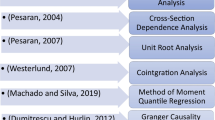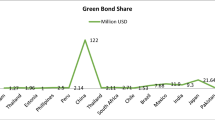Abstract
Taking the green credit policy in 2012 as a quasi-natural experiment, this paper applies the methods of propensity score matching and Difference-in-Difference (PSM-DID) to investigate the relationship between green credit policy and enterprises’ green technology innovation performance based on Chinese industrial enterprises database and green patent database. The results show that the implementation of “green credit guidelines” policy has significantly improved the green innovation performance of high-polluting and high-energy consuming enterprises, which indicates that the incentive effect of green credit policy on enterprises exceeds the constraint effect and leads to “Porter effect.” Moreover, the green credit policy has significantly increased the number of non-invention patents rather than invention patents. In addition, the green credit policy has a more significant effect on the green innovation performance of high-polluting and energy-intensive enterprises that are state-owned and have weak market power. Mechanism test shows that green credit policy can change the credit financing constraints and R&D investment allocation to affect the green innovation performance of high-polluting and energy-intensive enterprises.


Similar content being viewed by others
Data Availability
All data generated or analyzed during this study are included in this article.
Notes
SA index is calculated as (-0.737 * Size) + (0.043 * Size2) - (0.040 * Age), where Size denotes the log of inflation-adjusted assets and Age is the number of years the firm is listed.
policy1 is “Opinions on Implementing Environmental Policies and Regulations to Prevent Credit Risks” which was released by the State Environmental Protection Administration of China in 2007.
policy2 is “Guidelines on Building a Green Financial System” which was jointly issued by the seven ministries including the People’s Bank of China and the Ministry of Finance of China in 2016.
References
Aghion P, Askenazy P, Berman N, Cette G, Eymard L (2012) Credit constraints and the cyclicality of R&D investment: evidence from France. J Eur Econ Assoc 10:1001–1024
Ayyagari M, Demirguc-Kunt A, Maksimovic V (2011) Firm innovation in emerging markets: the role of finance, governance, and competition. J Financ Quant Anal 46:1545–1580
Baron RM, Kenny DA (1986) The moderator mediator variable distinction in social psychological-research - conceptual, strategic, and statistical considerations. J Pers Soc Psychol 51:1173–1182
Bertrand M, Duflo E, Mullainathan S (2004) How much should we trust differences-in-differences estimates? Q J Econ 119:249–275
Brandt L, Van Biesebroeck J, Zhang YF (2012) Creative accounting or creative destruction? Firm-level productivity growth in Chinese manufacturing. J Dev Econ 97:339–351
Cecere G, Corrocher N, Mancusi ML (2020) Financial constraints and public funding of eco-innovation: empirical evidence from European SMEs. Small Bus Econ 54:285–302
Chen YM, Schwartz M (2013) Product innovation incentives: monopoly vs. competition. J Econ Manage Strat 22:513–528
Chen Y, Kelly B, Wu W (2020) Sophisticated investors and market efficiency: evidence from a natural experiment. J Financ Econ 138:316–341
Cruz-Cazares C, Bayona-Saez C, Garcia-Marco T (2013) You can't manage right what you can't measure well: technological innovation efficiency. Res Policy 42:1239–1250
Cull R, Xu LXC (2003) Who gets credit? The behavior of bureaucrats and state banks in allocating credit to Chinese state-owned enterprises. J Dev Econ 71:533–559
Demirel P, Parris S (2015) Access to finance for innovators in the UK's environmental sector. Technol Anal Strateg 27:782–808
Fan SG, Li LX, Zhang XB (2012) Challenges of creating cities in China: lessons from a short-lived county-to-city upgrading policy. J Comp Econ 40:476–491
Ghisetti C, Mancinelli S, Mazzanti M, Zoli M (2017) Financial barriers and environmental innovations: evidence from EU manufacturing firms. Clim Pol 17:S131–S147
Gray WB, Shadbegian RJ (1995) Pollution abatement costs, regulation, and plant-level productivity. NBER working paper
Guan JC, Yam RCM, Tang EPY, Lau AKW (2009) Innovation strategy and performance during economic transition: evidences in Beijing, China. Res Policy 38:802–812
Hadlock CJ, Pierce JR (2010) New evidence on measuring financial constraints: moving beyond the KZ index. Rev Financ Stud 23:1909–1940
Horbach J (2008) Determinants of environmental innovation - new evidence from German panel data sources. Res Policy 37:163–173
Hou GS, Wang Y, Xin BG (2019) A coordinated strategy for sustainable supply chain management with product sustainability, environmental effect and social reputation. J Clean Prod 228:1143–1156
Jaffe AB, Newell RG, Stavins RN (2004) Technology policy for energy and the environment. Innov Policy Econ 4:35–68
Kapoor S, Oksnes L, Hogarth R (2011) Funding the green new deal: building a green financial system. Green European Foundation Green New Deal Series 6
Lemmon M, Roberts MR (2010) The response of corporate financing and investment to changes in the supply of credit. J Financ Quant Anal 45:555–587
Levinson A (1999) An industry-adjusted index of state environmental regulatory stringency. Discussion pap. Econ. Dep., Univ. of Wisconsin, Madison, WI
Li ZH, Liao GK, Wang ZZ, Huang ZH (2018) Green loan and subsidy for promoting clean production innovation. J Clean Prod 187:421–431
Liu Q, Qiu LD (2016) Intermediate input imports and innovations: evidence from Chinese firms' patent filings. J Int Econ 103:166–183
Liu JY, Xia Y, Fan Y, Lin SM, Wu J (2017) Assessment of a green credit policy aimed at energy-intensive industries in China based on a financial CGE model. J Clean Prod 163:293–302
Liu XH, Wang EX, Cai DT (2019) Green credit policy, property rights and debt financing: quasi-natural experimental evidence from China. Financ Res Lett 29:129–135
Porter ME, Vanderlinde C (1995a) Toward a new conception of the environment-competitiveness relationship. J Econ Perspect 9:97–118
Porter ME, Vanderlinde C (1995b) Green and competitive - ending the stalemate. Harv Bus Rev 73:120–134
Tsai KH, Liao YC (2017) Sustainability strategy and eco-innovation: a moderation model. Bus Strateg Environ 26:426–437
Tumelero C, Sbragia R, Evans S (2019) Cooperation in R & D and eco-innovations: the role in companies' socioeconomic performance. J Clean Prod 207:1138–1149
Wang E, Liu X, Wu J, Cai D (2019) Green credit, debt maturity, and corporate investment—evidence from China. Sustainability 11:583
Xu XK, Li JS (2020) Asymmetric impacts of the policy and development of green credit on the debt financing cost and maturity of different types of enterprises in China. J Clean Prod 264:121574
Zhang DY, Rong Z, Ji Q (2019) Green innovation and firm performance: evidence from listed companies in China. Resour Conserv Recycl 144:48–55
Zhang Y, Xing C, Wang Y (2020): Does green innovation mitigate financing constraints? Evidence from China's private enterprises. J Clean Prod 264:121698
Zhao XS, Lynch JG, Chen QM (2010) Reconsidering Baron and Kenny: myths and truths about mediation analysis. J Consum Res 37:197–206
Funding
This research work is supported in part by grants from National Natural Science Foundation of China (71803033), Natural Science Foundation of Guangdong Province (2019A1515011581), Philosophy and Social Sciences Planning Project of Guangdong Province (GD20SQ12), National Social Science Fund of China (19ZDA079), Guangzhou Philosophy and Social Science Planning Project (2020GZYB42, 2020GZGJ158), and Educational Science Planning Project of Guangdong Province (2020KZDZX1152).
Author information
Authors and Affiliations
Contributions
The authors confirm contribution to the paper as follows. Conceptualization: S.L., R.X., and X.C. Methodology: R.X. and S.L. Software: R.X. Formal analysis: S.L., R.X., and X.C. Investigation: S.L., R.X., and X.C. Writing, original draft preparation: R.X. and S.L. Writing, review and editing: S.L., R.X., and X.C. Visualization: R.X. Supervision: S.L. and R.X. Funding acquisition: S.L. and X.C. All authors have read and agreed to the published version of the manuscript.
Corresponding author
Ethics declarations
Ethics approval and consent to participate
Not applicable.
Consent for publication
Not applicable.
Competing interests
The authors declare that they have no competing interests.
Additional information
Responsible Editor: Ilhan Ozturk
Publisher’s note
Springer Nature remains neutral with regard to jurisdictional claims in published maps and institutional affiliations.
Rights and permissions
About this article
Cite this article
Liu, S., Xu, R. & Chen, X. Does green credit affect the green innovation performance of high-polluting and energy-intensive enterprises? Evidence from a quasi-natural experiment. Environ Sci Pollut Res 28, 65265–65277 (2021). https://doi.org/10.1007/s11356-021-15217-2
Received:
Accepted:
Published:
Issue Date:
DOI: https://doi.org/10.1007/s11356-021-15217-2




